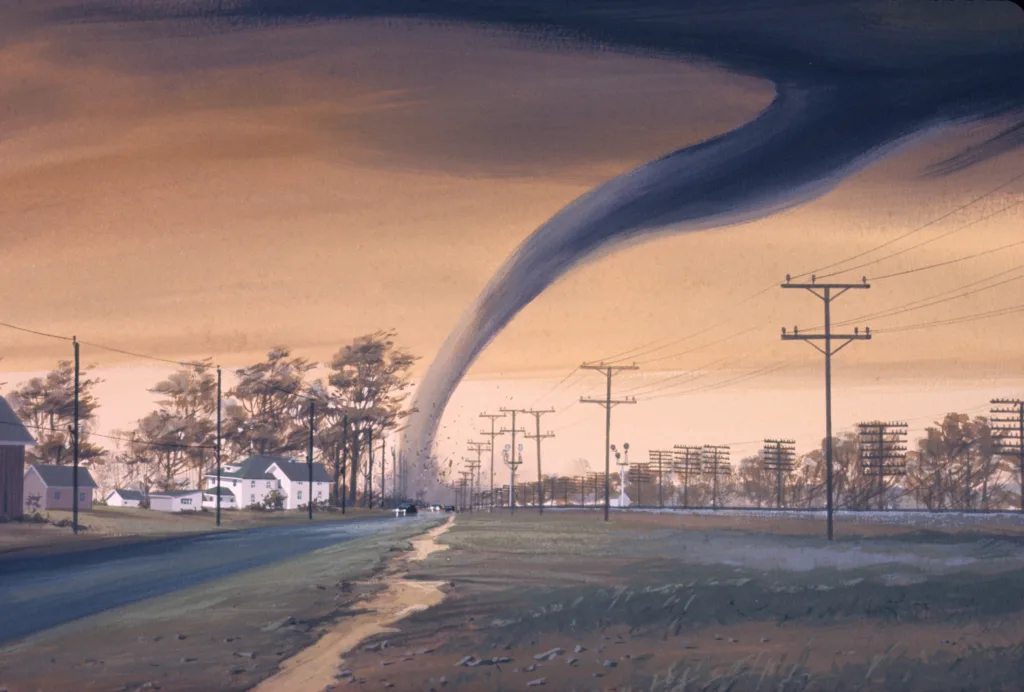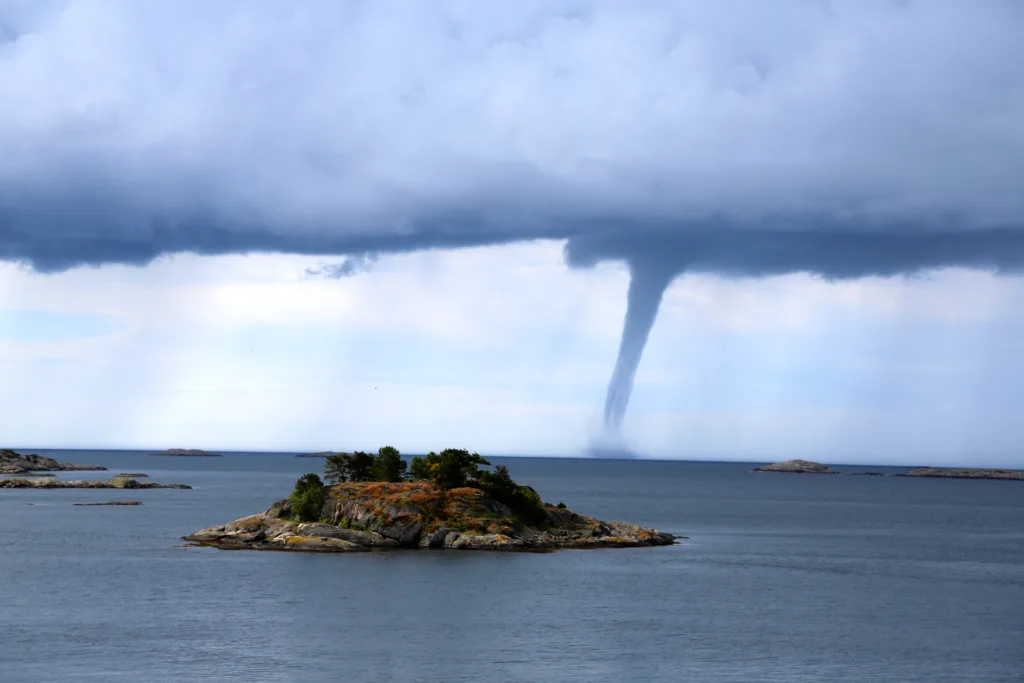Tornadoes are one of the most dangerous and unpredictable natural disasters that can occur. These violent storms can cause significant damage to homes, buildings, and communities. Tornadoes are often associated with thunderstorms and occur when warm, moist air collides with cool, dry air. The resulting differences in air pressure can cause rotating winds to form, which can then develop into a tornado.
The duration of a tornado can vary greatly depending on the strength and size of the storm. Typically, ground time for a tornado can range from an instant to several hours, although the typical time is around 5 to perhaps 10 minutes. Supercell tornadoes tend to be longer-lived, while those spawned by squall lines and bow echoes may only last for a few minutes.
The longest-lasting tornado on record was the Ellington, Missouri to Princeton, Indiana tornado on March 18th, 1925. This tornado lasted for an astonishing 3 ½ hours and traveled a distance of 352.4 km (219 mi.). The tornado caused widespread destruction and claimed the lives of 695 people.
Tornadoes are often preceded by warning signs that can help individuals and communities prepare for these deadly storms. These signs include a change in the color of the sky to a dark greenish color, a strange quiet occurring within or shortly after a thunderstorm, a loud roar that sounds similar to a freight train, an approaching cloud of debris, especially at ground level, and debris falling from the sky.
It is important to have a plan in place in case of a tornado. This plan should include identifying a safe location, such as a basement or interior room on the lowest level of a building, and havig a disaster preparedness kit on hand. It is also important to stay informed about weather conditions and to heed any warnings or evacuation orders issued by local authorities.
In conclusion, tornadoes are a powerful and dangerous natural disaster that can strike with little warning. The duration of a tornado can vary greatly, but it is important to take all necessary precautions to stay safe in case of a tornado. By staying informed and having a plan in place, individuals and communities can minimize the impact of these deadly storms.
Average Length of Tornadoes
Tornadoes are one of the most destructive and dangerous natural disasters, and their duration can range from a few seconds to several hours. However, on average, tornadoes tend to last aound 10 minutes, with a range of 5 to 15 minutes.
It’s important to note that the duration of a tornado can vary depending on various factors, including its size, intensity, and the environment in which it forms. Supercell tornadoes, for example, tend to be longer-lived, with a lifespan of several hours, while those spawned by squall lines and bow echoes may only last for a few minutes.
Additionally, the duration of a tornado can also be affected by the terrain it passes over. A tornado that travels over open fields or water may have a longer lifespan than one that moves through a densely populated urban area, where the tornado’s path may be obstructed by buildings, trees, and other structures.
While the average lifespan of a tornado is around 10 minutes, its duration can vary depending on a variety of factors.

The Duration of Tornadoes
Tornadoes are one of the most destructive natural phenomena that can occur on Earth. These violent storms are characterized by strong winds that rotate in a funnel-shaped cloud. The lifespan of a tornado can vary from a few seconds to several hours, and the distance it travels can range from a few meters to hundreds of kilometers.
According to the official records, the longest-lasting tornado that has been documented occurred on March 18, 1925, in the United States. This tornado lasted for thee and a half hours and traveled a distance of 352.4 kilometers (219 miles) from Ellington, Missouri, to Princeton, Indiana.
It is worth noting that the duration and distance of a tornado depend on various factors, including the strength of the storm, the terrain it passes over, and the atmospheric conditions. Some tornadoes can last for only a few seconds, while others can persist for several hours. Similarly, some tornadoes may travel only a few meters, while others can cover hundreds of kilometers.
While tornadoes can vary in lifespan and distance traveled, the longest-lasting tornado on record lasted for three and a half hours and traveled 352.4 kilometers from Ellington, Missouri, to Princeton, Indiana, back in 1925.
The End of Tornadoes
Tornadoes are devastating natural disasters that can cause widespread destruction and loss of life. However, just like any other weather phenomenon, tornadoes don’t last forever. They eventually come to an end, but how do tornadoes end?
Tornadoes are formed when a rotating column of air, also known as a vortex, is in contact with both the surface of the Earth and a cumulonimbus cloud. The vortex is created when warm, moist air rises rapidly, and cold air rushes in to replace it. This creates a rotating column of air that is capable of reaching wind speeds of up to 300 miles per hour.
The lifespan of a tornado depends on sevral factors, including the strength of the updraft that created it, the size of the vortex, and the amount of moisture and instability in the atmosphere. Generally, tornadoes last for a few minutes to an hour, but some can last for several hours.
Tornadoes end when the updraft that created them weakens or stops altogether. When this happens, the vortex loses its source of energy and begins to dissipate. As the vortex weakens, the tornado’s winds slow down, and it becomes less visible. Eventually, the funnel cloud disappears, and the tornado ends.
Another way that tornadoes can end is by encountering a change in the landscape. For example, when a tornado moves from a rural area to an urban area, it can encounter buildings and other structures that disrupt the vortex and cause it to weaken and eventually dissipate.
In summary, tornadoes end when the updraft that created them weakens or stops altogether, or when they encounter a change in the landscape that disrupts the vortex. While tornadoes are a powerful and destructive force of nature, they are not invincible, and they will eventually come to an end.
Warning Signs of a Possible Tornado
Tornadoes are one of the most destructive natural disasters, and they can strike quickly and unexpectedly. Knowing the warning signs of an impending tornado can be life-saving. Here are 5 warning signs that a tornado may occur:
1. Changes in the sky color: The sky may take on a greenish hue, which is caused by the reflection of light off hailstones within the thunderstorm. This is a clear indication that a tornado may be forming.
2. Unusual Quiet: If you notice an unusual quiet afer a thunderstorm, it may indicate that a tornado is forming. This is because a tornado can cause a decrease in air pressure, leading to a quiet atmosphere.
3. A loud roaring sound: The sound of a tornado has been described as similar to that of a freight train. If you hear such a sound, it is a clear indication that a tornado may be forming.
4. Debris in the sky: If you notice debris in the sky, especially at ground level, it may indicate that a tornado is forming. This debris may consist of dirt, leaves, or other materials.
5. Falling Debris: Falling debris is a clear indication that a tornado is already in progress. If you notice debris falling from the sky, take shelter immediately.
In conclusion, tornadoes are unpredictable and can form quickly, so it’s important to be aware of the warning signs that a tornado may occur. By being vigilant and taking appropriate action, you can protect yourself and your loved ones from this destructive natural disaster.

Conclusion
Tornadoes are powerful and destructive weather phenomena that can cuse immense damage to property and loss of life. They are formed when warm, moist air rises and meets colder, drier air in the atmosphere, creating a rotating column of air that can reach speeds of over 300 miles per hour. While tornadoes cannot be prevented, there are warning signs that can help people prepare and take shelter before they strike. It is important to stay informed and listen to local authorities during severe weather events. By taking precautions and being aware of the dangers, we can minimize the impact of tornadoes and keep ourselves and our communities safe.
